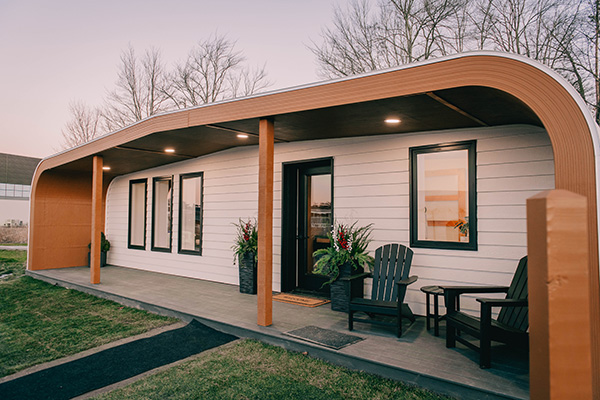The world’s first 3D-printed house made entirely from bio-based materials was unveiled by the University of Maine Advanced Structures and Composites Center (ASCC) in late 2021. Since that time, and after testing under a full range of weather conditions, data has confirmed the technology is sound.
“BioHome3D endured one of Maine’s most volatile weather years, with sensors reporting temperatures from 1F to 105F, extreme wind storms that caused blackouts throughout the state and a number of snowstorms,” the university said.
The 600-square-foot prototype called BioHome3D was developed with funding from the U.S. Department of Energy’s Hub and Spoke program, in partnership with the University and the Oak Ridge National Laboratory.
As the University of Maine explained in a , the concept of 3D printed houses can address labour shortages and supply chain issues. However, what makes BioHome3D even more appealing is the use of environment-friendly materials in the 3D printing process rather than concrete.
The 3D-printed floors, walls and roof were created from wood fibres and bio-resins. The wood fibre consisted of wood flour or fine sawdust. The prototype is highly insulated with 100 per cent wood insulation which can be customized for various R-values.
“The biomaterials used are 100 per cent recyclable, so our great-grandchildren can fully recycle BioHome3D,” explained ASCC executive director Dr. Habib Dagher. That includes the corn-based bioplastic binding agent that was developed by Dagher and his ASCC team. In fact, the homes could be deconstructed, ground up and reprinted again.
Maine’s expansive forestry and paper industry makes wood waste a promising material for this 3D printing technology. The state’s mills reportedly produce 1.6 million tons of wood waste each year. Finding economical and environmentally viable ways to dispose of this waste has long been a challenge. The BioHome3D innovation could help. Calculations suggest 100,000 homes the size of BioHome3D could be produced each year from this annual waste alone.
“Printing using abundant, renewable, locally sourced wood fibre feedstock reduces dependence on a constrained supply chain,” the University of Maine said. “These materials support the revitalization of local forest product industries and are more resilient to global supply chain disruptions and labour shortages.”

Furthermore, as a result of 3D printing precision, Dagher and his team believe construction waste could be eliminated almost entirely.
But to actually create the components, the ASCC team needed a massive 3D printer. For this, they turned to the Army Corps of Engineers to fund what turned out to be the world’s largest 3D polymer printer at over 18 metres long. Now located on the University of Maine campus, it can print objects up to 29-metres-by-10 metres-by-5.5-metres.
BioHome3D was printed in four modules, moved to the site and assembled in half a day. Electrical service was installed by a single electrician and was up and running within two hours. Unlike the stark, grey interiors of 3D printed concrete buildings, BioHome3D’s interior is warm and inviting due to the natural wood hues of the printed walls, ceilings and floors.
Motivating the project is the severe nationwide housing shortage that has not bypassed Maine. Nearly 60 per cent of the state’s low-income renters spend more than half of their income on housing.
Daniel Brennan, director of MaineHousing, spoke of the potential to speed up home construction through 3D mass production.
“The idea that we can create housing units in a fraction of the time with a fraction of the workforce is an efficiency that we’ve never experienced before.”
BioHome3D is part of an ASCC plan to scale its advanced manufacturing research in housing construction with the opening of the Green Engineering and Materials (GEM) research Factory of the Future.
“When complete, GEM will serve as a hub for AI-enabled large-scale digital hybrid manufacturing. The Factory of the Future will drive innovation-led economic recovery in Maine, with bays dedicated to scaling up the production of housing, such as BioHome3D, as well as boatbuilding, an important Maine industry.”
John Bleasby is a Coldwater, Ont.-based freelance writer. Send comments and Inside Innovation column ideas to editor@dailycommercialnews.com.











Recent Comments
comments for this post are closed